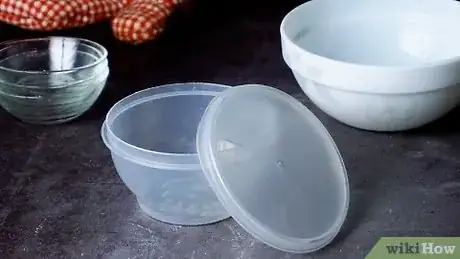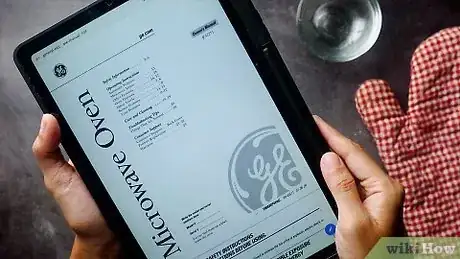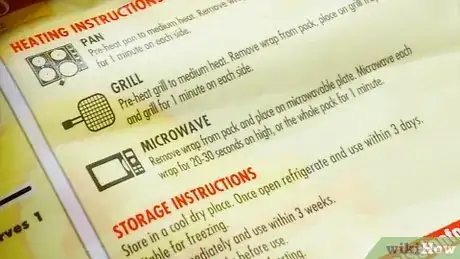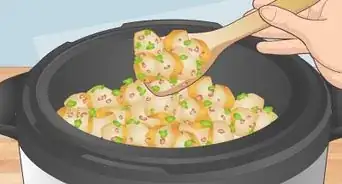This article was co-authored by wikiHow Staff. Our trained team of editors and researchers validate articles for accuracy and comprehensiveness. wikiHow's Content Management Team carefully monitors the work from our editorial staff to ensure that each article is backed by trusted research and meets our high quality standards.
There are 14 references cited in this article, which can be found at the bottom of the page.
The wikiHow Culinary Team also followed the article's instructions and verified that they work.
This article has been viewed 277,316 times.
Learn more...
In recent years, there has been growing concern about potentially hazardous substances leeching into food from microwave containers.[1] Most of the concern focuses on plastic containers, specifically those containing bisphenol-A (BPA) or phthalates.[2] But you may use the microwave for the convenience of reheating and thawing foods. By informing yourself on different products available to heat food in the microwave, you can choose the best containers for your needs and protect your health.
Steps
Finding Safe Dishes
-
1Be aware of potential health hazards. Some microwavable containers, especially those made of plastic, can be potentially harmful to your health. Others, like glass or plastic dishes, are better for your health. Informing yourself about the potential dangers of certain types of microwave-safe containers may help you make a safer choice.[3] Some of the potential health hazards are:
- ”Endocrine disruption,” which mimics human hormones.[4] This may have effects such as modifying chemical signals that regulate metabolism and reproduction.
- Miscarriage and birth defects
- Lower sperm counts
- Early puberty
- Cancer
- Obesity and diabetes
- Neurobehavioral abnormalities.
-
2Learn what substances to avoid. “Plastic” is a generic term for different materials, or plasticizers, that can form microwave containers. In particular, it's plastic containers with BPA, phthalates, polyvinyl chloride, and polycarbonate that may harm your health. Although the Food and Drug Administration (FDA) closely regulates plastic containers and materials that come in contact with foods, you may still want to learn and avoid potentially hazardous chemicals. The following containers may be harmful if microwaved with food:[5]
- Plastic dishes
- Some Styrofoam containers
- Plastic storage or shopping bags
- Plastic wrap
- Takeout food containers, water bottles, and plastic tubs or jars that hold foods like margarine, yogurt, mayonnaise, or mustard.[6]
- Soft plastic containers
Advertisement -
3Look for safety designations. In many cases, containers are manufactured to be microwave-safe and may have labels on their packing and the products indicating this. In addition, you may want to make sure that the containers also bear other markers that can indicate they're safe for microwave use and your health. Check packaging and the product for the following symbols or statements:[7]
- A label ”microwave-safe”
- A symbol of a dish with wave-like lines above it.
- A symbol of lines of waves.
- A symbol of a triangle, or Mobius loop, with a number in it. The number designates the type of plasticizer used in the product, which you may want to avoid.
-
4Search your pantry. You may already have microwave- safe containers in your kitchen. Before purchasing new containers, look in your pantry to see what you have and can use.
- Read containers for labels including “microwave-safe.”[8]
- Be aware that there is no consensus on plastic wrap and microwaves. If you use plastic wrap in the microwave, make sure the packaging says “microwave-safe.”[9]
- Check for containers that are old, scratched, cracked, or have been used frequently. These may leech out more harmful materials. Consider throwing these away and investing in new containers.[10]
- Make sure glass or ceramic containers have the “microwave-safe” label and do not contain any materials, such as rims, made of gold or other materials not safe for the microwave.[11]
- Be aware that, contrary to popular belief, you can microwave some Styrofoam or other polystyrene containers. Just make sure to check that they are labeled microwave-safe.[12]
-
5Purchase new containers. Even if you need microwave-safe containers and want to buy new ones, it's easy to find microwave-safe options at most retailers. Read package labeling and the product itself for descriptions and symbols that designate the product microwave-safe.[13]
- Remember that glass and ceramic containers are the safest options for microwaving. Check to make sure that they also carry the “microwave-safe” designation.[14] Just be aware that these products may be more expensive than plastic, though they may also last longer.
- Buy plastic containers and wrap marked microwave-safe.
- Consider checking the Good Housekeeping Institute's test results for the best and safest containers to use in the microwave.[15]
-
6Run a safety test. There is a method you can use to check a container's safety that you are unsure of or one that has a microwave-safe label. Running this safety test may help you decide if you want to use the container or opt for another one.[16]
- Empty the container you want to test and place it inside the microwave.
- Put a second container containing one cup of tap water inside the microwave.
- Heat the microwave on high for one minute. If the empty container is cool, it's safe to use in the microwave. If it is warm, use it only to reheat food and if it is hot, don't use it in the microwave at all.
Using Safe Microwaving Practices
-
1Read microwave instructions. Microwaves make many things in our lives easier. But they don't come without potential hazards and it's important to read the instruction manual for your microwave to avoid harming yourself or others.[17]
- Contact the microwave's manufacturer if you have any questions.
- Check online for product manuals if you lost your instruction packet.
- See if there are specific suggestions on the type of containers or wrap you can use. For example, some microwaves can use specific types of aluminum foil, while others can't.
- See if there are instructions or suggestions for specific foods. For example, most meats cannot be cooked at full power, but instead at half power for longer.
-
2Follow prepared food instructions. If you want to cook prepared foods in your microwave, read the packaging instructions. In most cases, these containers can only be microwaved once and may also have specific heating requirements.[18]
- Vent containers if required by puncturing them with a fork or peeling back a corner of the plastic wrap.[19]
- Make sure you closely check the heating requirements. For example, some foods can only be cooked at 50% power and not following this could ruin your meal and your microwave.
-
3Arrange food for reheating. If you're going to use a covered dish to reheat food, it's arrangement in the container can affect the heating process. Arranging your food evenly within the container can help ensure uniform cooking and may help destroy harmful bacteria.[20]
-
4Cover food safely. In many cases, you may need to cover food you've prepared yourself to heat it in the microwave. Making sure you use safe types of covers and vent the container can ensure that you don't cause unsafe chemicals to leech into your food.[21]
- Choose plastic wrap that is labeled microwave-safe. However, never let it contact your food.
- Consider using waxed or kitchen parchment paper, white paper towels or plates, or a domed microwave container to cover your food.[22]
- Loosen or vent the lid or any wrap to allow steam to escape.
- Stay away from brown paper bags, newspaper, foam containers, and most aluminum foil as covers.
-
5Check food during cooking. Midway through the microwaving process, check your food to make sure it is cooking properly. Consider rotating or stirring the food to eliminate cold spots.[23]
- Be aware that cold spots in food can contain harmful bacteria.
- Use a food thermometer to check temperatures, especially of meat.
Community Q&A
-
QuestionAre acrylic coffee mugs microwave safe?
 Community AnswerIt depends on the brand. You can usually tell by looking at the bottom or checking online on the brand's website.
Community AnswerIt depends on the brand. You can usually tell by looking at the bottom or checking online on the brand's website. -
QuestionAre microwavable dinner foods safe in the microwave?
 Community AnswerYes. Any microwaveable food packages that say they are safe in the microwave, should be.
Community AnswerYes. Any microwaveable food packages that say they are safe in the microwave, should be. -
QuestionCan I microwave plastic?
 Community AnswerNo, unless the plastic is marked as microwave safe.
Community AnswerNo, unless the plastic is marked as microwave safe.
Warnings
- Use caution when removing items from the microwave oven. Remove the lid or cover with care to avoid being burned. Check the temperature of the container before lifting it with your hands.⧼thumbs_response⧽
- Never use the microwave to can vegetables or to sterilize the glass jars used for canning.[24]⧼thumbs_response⧽
References
- ↑ http://www.health.harvard.edu/staying-healthy/microwaving-food-in-plastic-dangerous-or-not
- ↑ https://www.chemicalsafetyfacts.org/is-it-safe-to-microwave-plastic-answering-common-safety-questions-about-plastics-food-packaging/
- ↑ http://goaskalice.columbia.edu/answered-questions/are-plastic-wrap-and-containers-safe-microwaving-food
- ↑ http://www.health.harvard.edu/staying-healthy/microwaving-food-in-plastic-dangerous-or-not
- ↑ https://www.chemicalsafetyfacts.org/is-it-safe-to-microwave-plastic-answering-common-safety-questions-about-plastics-food-packaging/
- ↑ http://www.health.harvard.edu/staying-healthy/microwaving-food-in-plastic-dangerous-or-not
- ↑ https://www.fda.gov/consumers/consumer-updates/5-tips-using-your-microwave-oven-safely
- ↑ http://goaskalice.columbia.edu/answered-questions/are-plastic-wrap-and-containers-safe-microwaving-food
- ↑ https://www.thekitchn.com/is-it-safe-to-use-plastic-wrap-in-the-microwave-222348
- ↑ http://www.health.harvard.edu/staying-healthy/microwaving-food-in-plastic-dangerous-or-not
- ↑ https://www.cbs7.com/content/news/Guide-How-to-Tell-if-Something-is-Microwave-Safe-351098051.html
- ↑ https://www.chemicalsafetyfacts.org/is-it-safe-to-microwave-plastic-answering-common-safety-questions-about-plastics-food-packaging/
- ↑ http://www.goodhousekeeping.com/institute/a17859/plastic-safety-heat-food/
- ↑ http://www.goodhousekeeping.com/institute/a17859/plastic-safety-heat-food/
- ↑ http://www.goodhousekeeping.com/institute/a17859/plastic-safety-heat-food/
- ↑ http://msue.anr.msu.edu/news/use_only_microwave_safe_containers_when_cooking_and_reheating_foods
- ↑ https://www.ccohs.ca/oshanswers/phys_agents/microwave_ovens.html
- ↑ https://www.fsis.usda.gov/food-safety/safe-food-handling-and-preparation/food-safety-basics/cooking-microwave-ovens
- ↑ https://www.fsis.usda.gov/food-safety/safe-food-handling-and-preparation/food-safety-basics/leftovers-and-food-safety
- ↑ https://www.fsis.usda.gov/food-safety/safe-food-handling-and-preparation/food-safety-basics/leftovers-and-food-safety
- ↑ https://www.fsis.usda.gov/food-safety/safe-food-handling-and-preparation/food-safety-basics/cooking-microwave-ovens
- ↑ http://www.health.harvard.edu/staying-healthy/microwaving-food-in-plastic-dangerous-or-not
- ↑ https://www.fsis.usda.gov/food-safety/safe-food-handling-and-preparation/food-safety-basics/cooking-microwave-ovens
- ↑ https://extension.psu.edu/canners-and-canning-methods-that-are-not-recommended
About This Article
To choose a microwave safe container, start by checking the packaging or the bottom of the dish for labels such as “microwave-safe” or a wavy line symbol, which means the container can be microwaved. Also, avoid containers that are made of soft plastic, since they can contain harmful chemicals. If you can, use glass or ceramic containers, since they are usually the safest option and last the longest. For tips on how to test if a container is microwave safe before heating food in it, read on!




























































Medical Disclaimer
The content of this article is not intended to be a substitute for professional medical advice, examination, diagnosis, or treatment. You should always contact your doctor or other qualified healthcare professional before starting, changing, or stopping any kind of health treatment.
Read More...